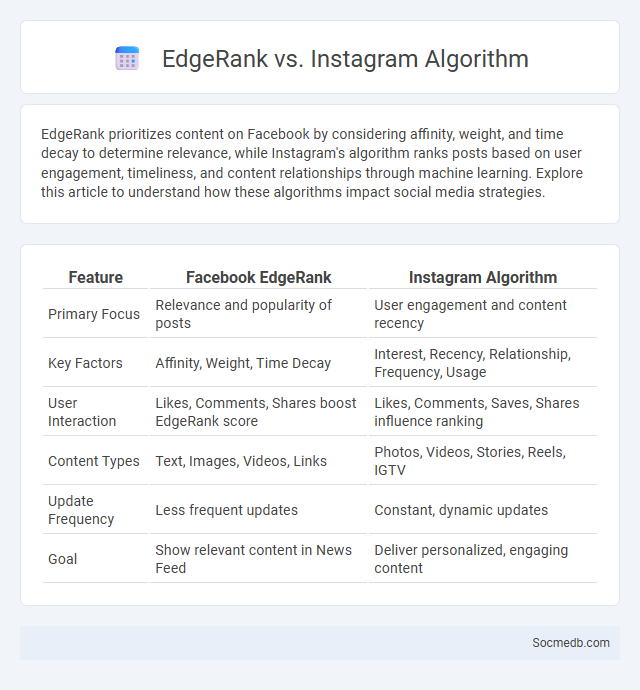
Photo illustration: EdgeRank vs Instagram Algorithm
EdgeRank prioritizes content on Facebook by considering affinity, weight, and time decay to determine relevance, while Instagram's algorithm ranks posts based on user engagement, timeliness, and content relationships through machine learning. Explore this article to understand how these algorithms impact social media strategies.
Table of Comparison
| Feature | Facebook EdgeRank | Instagram Algorithm |
|---|---|---|
| Primary Focus | Relevance and popularity of posts | User engagement and content recency |
| Key Factors | Affinity, Weight, Time Decay | Interest, Recency, Relationship, Frequency, Usage |
| User Interaction | Likes, Comments, Shares boost EdgeRank score | Likes, Comments, Saves, Shares influence ranking |
| Content Types | Text, Images, Videos, Links | Photos, Videos, Stories, Reels, IGTV |
| Update Frequency | Less frequent updates | Constant, dynamic updates |
| Goal | Show relevant content in News Feed | Deliver personalized, engaging content |
Introduction to Social Media Algorithms
Social media algorithms analyze user behavior, preferences, and engagement patterns to curate personalized content feeds, enhancing user experience and platform interaction. These algorithms prioritize posts based on factors like relevance, recency, and user relationships to maximize content visibility and retention. Understanding the mechanics behind algorithms on platforms such as Facebook, Instagram, and TikTok helps businesses and creators optimize their content strategy for better reach and engagement.
What Is EdgeRank?
EdgeRank is the algorithm Facebook uses to determine which posts appear in a user's News Feed by analyzing factors like affinity, weight, and time decay. It evaluates user interactions, such as likes, comments, and shares, assigning scores to prioritize content relevance and engagement. Understanding EdgeRank helps marketers optimize content visibility and improve audience reach on Facebook.
How the Instagram Algorithm Works
The Instagram algorithm prioritizes content based on user engagement, including likes, comments, shares, and time spent on posts, to deliver personalized experiences. Machine learning models analyze patterns like user interaction history, content type, and recency to rank posts in the feed and Explore section. This algorithmic approach ensures that high-quality, relevant content from accounts users frequently engage with appears more prominently.
Key Differences Between EdgeRank and Instagram Algorithm
EdgeRank, Facebook's original ranking algorithm, prioritizes content based on affinity, weight, and decay to determine user feed order, focusing heavily on user interactions such as likes, comments, and shares. In contrast, Instagram's algorithm uses machine learning to analyze user behavior, including engagement patterns, content type preference, and recency, providing a more personalized and dynamic feed experience. While EdgeRank emphasizes relationship strength and post popularity, Instagram's algorithm incorporates a broader range of signals like time spent on posts and direct shares to optimize content visibility.
Factors Influencing EdgeRank
EdgeRank, the algorithm that determines the visibility of your content on social media platforms like Facebook, is influenced by three main factors: affinity, weight, and time decay. Affinity measures the relationship strength between you and your audience, with more interactions increasing visibility, while weight assigns different values to content types such as comments, likes, or shares, prioritizing more engaging actions. Time decay reduces the significance of older posts, favoring fresh content to keep your social feed relevant and dynamic.
Ranking Signals in the Instagram Algorithm
Ranking signals in the Instagram algorithm prioritize user engagement metrics such as likes, comments, shares, and saves to determine content visibility. The algorithm also factors in relationship strength between users, frequency of interactions, and the timeliness of posts to deliver personalized feed experiences. Hashtags, content relevance, and video completion rates further influence how posts rank within the Explore page and user feeds.
Content Visibility: Facebook vs Instagram
Content visibility on Facebook is influenced by its complex algorithm that prioritizes posts based on relevance, engagement, and user interactions, making it essential for your content to generate meaningful engagement to reach a broader audience. Instagram, on the other hand, emphasizes visual content and uses a real-time, interest-based feed algorithm that favors high-quality images and videos, stories, and consistent posting to maximize exposure. Understanding these platform-specific dynamics can help you tailor your social media strategy to enhance content visibility effectively.
User Engagement and Algorithm Performance
User engagement on social media platforms directly influences algorithm performance by driving content visibility and personalization. Algorithms prioritize content with higher interaction rates such as likes, comments, shares, and watch time to enhance user experience and retention. Optimizing user engagement strategies improves algorithmic recommendations, resulting in increased platform activity and targeted content delivery.
Adapting Content Strategy for Each Platform
Tailoring your content strategy to each social media platform enhances engagement and reach by addressing the unique preferences and algorithms of sites like Instagram, Twitter, and LinkedIn. Visual-driven platforms require high-quality images and short videos, whereas LinkedIn favors professional articles and in-depth posts. Understanding these distinctions allows you to optimize your messaging and connect effectively with your audience on every channel.
Future Trends in Social Media Algorithms
Future trends in social media algorithms emphasize increased personalization through artificial intelligence and machine learning, enabling platforms to deliver highly relevant content tailored to individual user preferences. Enhanced predictive analytics will allow algorithms to better anticipate user behavior, boosting engagement and retention rates. Privacy-centered algorithmic designs are emerging, ensuring compliance with global data protection regulations while maintaining content relevance and user trust.
 socmedb.com
socmedb.com